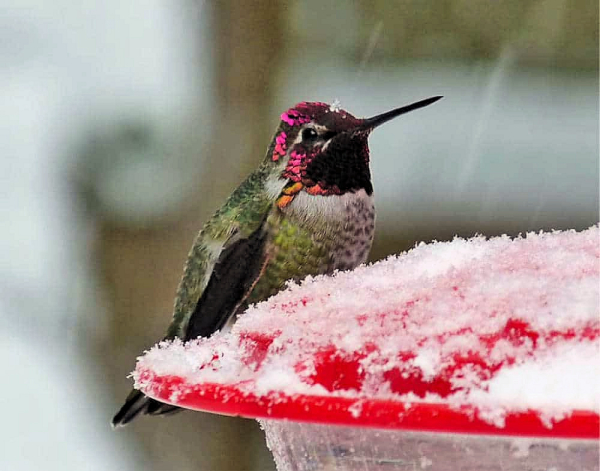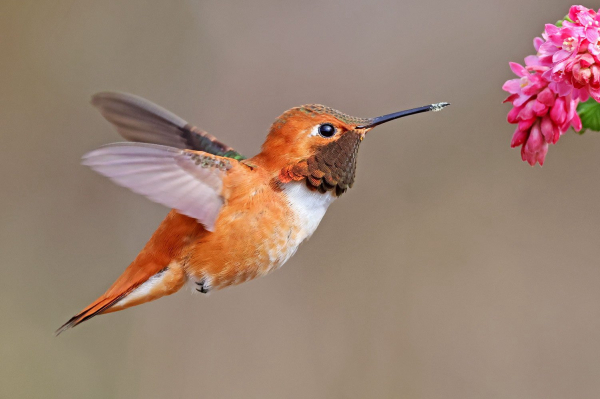
A male Anna’s Hummingbird was photographed at a nectar feeder during a light snowfall in Prescott, Arizona by Dede Erceg.

Rufous Hummingbirds are a western species that are the most likely to venture far east of their normal range. They normally winter in southwest Mexico.
|
While birders in some southwest states have resident hummingbirds visiting their nectar feeders year-round, it’s interesting to learn about winter sightings farther north. A dramatic example is an Anna’s Hummingbird that was visiting a feeder last week in, of all places, northern Michigan – in a backyard in the snowy small town of Arcadia near the east shore of Lake Michigan – and it established a first state record! But perhaps the most interesting example of winter hummingbird sightings takes place in Louisiana, a state that hosts 2 native species during summer, but attracts as many as 8 species of hummingbirds during winter during recent years.
Wintering hummingbirds have become a point of interest for many Louisiana birders, where hummingbirds that nest far west and far northwest of Louisiana, are found annually in parishes across the state. Thankfully, Erik Johnson has created a team of birders who provide feeders and flowering plants throughout the year, and they report hummingbirds they find “out of season,” when most hummingbirds of these species winter south of the American border, or in the case of Anna’s and Allen’s Hummingbirds, to the far west.
The following information was provided by Erik Johnson in his Louisiana Winter Hummingbird Weekly Report #4 of the 2024-25 winter season. Erik begins with an overview for the first half of the season: There continues to be a steady stream of winter hummingbird reports with 361 hummingbirds reported. The “Rocky Mountain species” (Calliope and Broad-tailed Hummingbirds) are surprisingly sparse, but Black-chinned and Broad-billed Hummingbirds are being seen in above average numbers.
Although Erik explained that no Allen’s Hummingbirds have been positively identified yet, it’s likely some are among the group referred to as “Rufous/Allen’s Hummingbirds.” He also notes that young male Allen’s Hummingbirds will get easier to identify as they molt into adult plumage this winter. Species totals were reported as:
40 Ruby-throated Hummingbirds in 13 parishes at 28 sites;
20 Buff-bellied Hummingbirds in 14 parishes at 19 sites;
54 Black-chinned Hummingbirds in 16 parishes at 39 sites;
9 Broad-billed Hummingbirds in 8 parishes at 8 sites;
5 Broad-tailed Hummingbirds in 4 parishes at 5 sites;
3 Calliope Hummingbirds in 3 parishes at 3 sites;
49 Rufous Hummingbirds in 16 parishes at 36 sites;
174 Rufous/Allen’s Hummingbirds in 24 parishes at 101 sites; and
7 unidentified species that belong to the Archilochus genus in 6 parishes at 7 sites.
Winter Feeder Availability
It has been suggested that a good rule of thumb for backyard birders is to keep your hummingbird feeders up if you live in a location where the nectar does not freeze. Some individual hummingbirds don’t make it to their species’ normal nesting range, and may find your nectar feeder. At the same time, individual hummingbird species that range south of the American/Mexican border make it into the United States during winter months periodically too. And don’t worry, providing winter nectar won’t prevent hummingbirds or any other species from migrating. Lingering orioles and House Finches will appreciate sugar-water nectar too.
For people in southern California, southern Arizona, and southern Texas, it’s business as usual to keep your hummingbird feeders stocked with fresh sugar-water nectar for local hummingbirds, and maybe some rarer winter visitors. At the same time, Anna’s Hummingbirds are already nesting in southern California and points beyond. There is no doubt that hummingbirds are interesting birds, and you can learn more about where their normal winter ranges are by referring to each species at Ruby-throated Hummingbird Overview, All About Birds, Cornell Lab of Ornithology, then type in the name of the next hummingbird species you want to check the range map for and learn more about that species.
Share your backyard birding experiences and photographs with The Birding Wire at editorstbw2@gmail.com